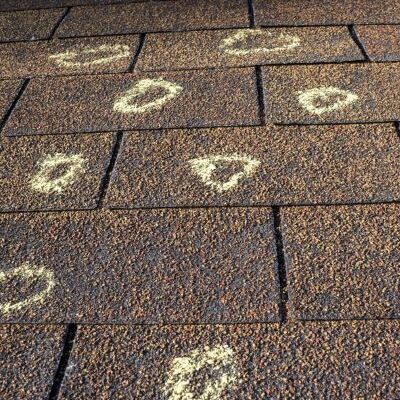
What to look for in the wake of a storm
There are few things in the life of a commercial business or homeowner that brings on the stress quite like a major storm. Inclement weather is unpleasant enough without the harsh reality that the storm could be doing major damage to your roof.
This is a nightmare scenario for many of us: a major storm hits, and your roof is left in shambles. Then comes the costly repairs and the headaches that come with major repairs or, the worst-case scenario, a complete roof replacement.
How do I know if my roof has storm damage?
Unfortunately, there is no single universal sign of damage to your roof. In fact, because the roof is so high up, you might not be able to even see the damage without being on the roof itself. There are, however, a few of the more common indications that damage has been done to your roof.
If heavy winds have hit your area, you may notice missing shingles. There are less obvious signs of wind damage as well. The thin horizontal lines where the granules have been worn off about an inch or two beneath the shingle may become evident. This indicates that the shingle was broken and potentially flapping due to the strength of the wind.
This is important because your shingles are what help to keep your roof watertight. Without them, moisture could get into your home and cause damage to areas other than the roof.
There is also the case of discoloration from heavy water damage that can be seen from the ground. Typically it is hardest to determine if you have incurred roof damage after a hail storm. Dents to areas of your home typically cannot be seen from the ground and require a formal inspection to spot.
What causes roof damage?
There are three main factors that can seriously damage a roof. It is important to note that your roof is technically being damaged just about every single day. Even if the weather in your area is perfect, it is still taking a pounding from the UV rays that the sun projects.
In any event, the first major factor is wind damage. High enough winds can peel up portions of shingles or other areas of the roof. This compromises the integrity of the shingles around it as well as the roof as a whole.
Water damage is another major contender. If a storm is heavy enough, that water can beat down on your roof and make its way underneath the roofing material. This can lead to leaks as well as structural damage to the roof and other areas of your home.
Lastly, hail is another major factor in damage. Most roofs are now equipped to handle hail of most sizes, simply letting it bounce away. But if the hail is large enough, it can leave indentations in your roof and the other appliances on your rooftop that are there.
Hail damage is perhaps the most difficult when it comes to storm damage to spot because it can be subtle unless you get right on top of it. In most cases, hail damage can be an annoyance, compromising the structural integrity of the shingles or other areas of the roof. In major hail cases, it can cause holes that can lead to leaks and other damage to your roof.
Can I claim roof damage on insurance?
The short answer to this question is a “yes, but…” Damage to your roof from the aforementioned factors typically falls under being covered by peril. In most cases, your homeowners’ policy will help cover the cost of the repairs if not completely cover them.
The problem here is in dealing with the insurance company. The process can be a long one as the insurance company has to send a claims adjustor out to inspect the damage and make sure that it wasn’t caused through negligence or lack of maintenance.
They do this because insurance companies will find any reason to not pay that claim out. They are in the business of taking your money, not paying it out. Still, if you can reasonably show that your roof was in good condition and simply damaged by severe weather, they will end up covering at least some of it.
How do I know if my roof needs replacing?
This could be one thing or a series of issues coming together at once. If you have shingle roofing, there are a few signs to look for. If the majority of your shingle edges are cupped or curled, if the shingles themselves are cracked, or if there are bald spots where the granules are missing, it may be time to replace your roof.
If your roof is over 20 years old and has experienced recent storm damage in Austin, TX, it may also be time to replace them. Really, the best bet is to talk to your local roofing contractor and get an opinion and a quote from them. A reputable company like Texas Cool Roofing & Waterproofing will advise you for or against a replacement based on your current situation. You can find out more about how we can help by calling 512-617-7335.
